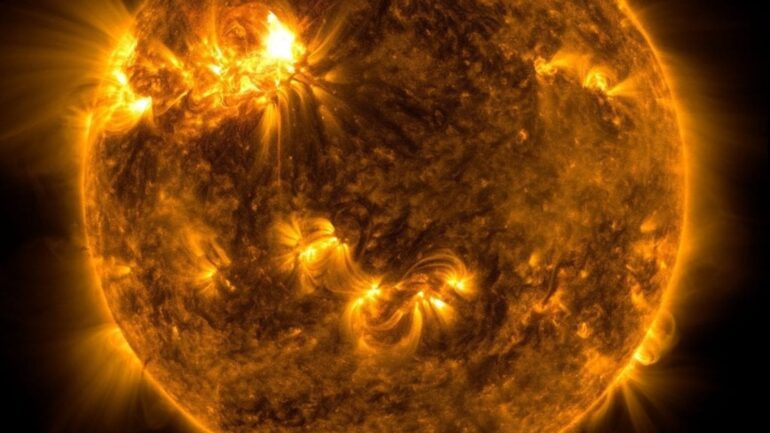TL;DR:
- The sun’s outer atmosphere, the corona, is inexplicably hotter than its visible surface, but the cause remains unknown.
- Researchers at Northumbria University, in collaboration with Lockheed Martin Solar and Astrophysics Laboratory, are employing AI to solve this longstanding solar mystery.
- They are training AI algorithms to detect “nanojets” released during small flares called nanoflares, which could contribute to the corona’s extreme heat.
- Another AI-led investigation focuses on the phenomenon of “coronal rain,” where magnetic reconnection causes localized temperature drops and plasma clumps that fall back toward the corona.
- AI’s role in exploring these phenomena could provide insights into the mechanisms behind the sun’s scorching corona.
Main AI News:
The blazing mystery of the sun’s outer atmosphere has baffled scientists for ages. Surpassing a searing 1.8 million degrees Fahrenheit (1 million degrees Celsius), the sun’s corona far outshines its visible “surface” – the photosphere – which emits at a scorching 10,340 degrees F (5,730 degrees C) at its peak. Yet, the origins of the corona’s extreme heat remain elusive.
Two theories vie for dominance in explaining this astronomical enigma: the liberation of heat from dissipating plasma waves coursing through the corona and the release of energy resulting from the breaking and reconnecting of magnetic field lines. While both mechanisms are evident in solar dynamics, determining the primary contributor to the corona’s heating, or whether both play an equal role, remains an enigma.
In an endeavor to unravel this celestial puzzle, researchers from Northumbria University, UK, are harnessing the power of artificial intelligence. Patrick Antolin and Ramada Sukarmadji, in collaboration with scientists from the Lockheed Martin Solar and Astrophysics Laboratory, are employing machine learning techniques to identify minute flares that generate “nanojets” within the corona.
The concept of nanoflares was conceived by solar physicist Eugene Parker, the namesake of NASA’s Parker Solar Probe, in the late 1980s. Parker theorized that when magnetic field lines twist and snap, producing a magnetic reconnection event, an intense surge of energy is released. In 2021, Antolin and a team of scientists, leveraging data from NASA’s Interface Region Imaging Spectrograph (IRIS) mission, detected nanoflares for the first time. Now, the pivotal question is whether nanoflares occur frequently enough to account for the corona’s astronomical temperatures.
Detecting nanoflares and their ensuing nanojets is a formidable challenge due to their diminutive nature. “Currently, we can only identify nanojet occurrences visually; what we need is an automated means of detection,” explained Sukarmadji. “Due to their minuscule size and the limited evidence at our disposal, it is likely that their prevalence exceeds our current estimations. However, to gain a comprehensive understanding, real-time detection is imperative.“
By training AI algorithms to identify nanojets in imagery captured by space missions like IRIS, the Parker Solar Probe, NASA’s Solar Dynamics Observatory (SDO), and the European Space Agency’s Solar Orbiter, the team aims to shed light on the frequency of nanoflare occurrences.
Another intriguing phenomenon tied to magnetic reconnection within the corona, sought after by AI, is known as “coronal rain.” This phenomenon arises when magnetic reconnection triggers localized temperature drops within the corona, leading to denser plasma clusters, spanning approximately 150 miles (250 kilometers) in diameter. These clusters then plummet from the corona at a breathtaking speed of 62 miles (100 km) per second, akin to colossal shooting stars. Upon impacting the photosphere, they create fleeting yet dazzling flashes and shock waves, propelling scorching plasma back toward the corona.
Antolin, along with his colleague, Luke McMullan, a solar physicist from Northumbria, is training AI using IRIS images of coronal rain. Subsequently, they employ these refined algorithms to scrutinize lower-resolution images from the SDO, searching for telltale signs of coronal rain.
These dual pursuits, propelled by AI, might finally unlock the secrets behind the sun’s inexplicably intense corona, settling the question of its scorching temperament once and for all.
Conclusion:
The utilization of artificial intelligence in unraveling the sun’s fiery secrets holds significant implications for the market. The advancements in AI-driven research and analysis enable scientists to tackle longstanding questions about the sun’s behavior, particularly the inexplicably hot corona. Understanding the underlying mechanisms responsible for the corona’s extreme heat can lead to advancements in solar physics, space exploration, and energy technologies.
Moreover, the development of AI algorithms for automated detection and analysis opens up new possibilities for monitoring and predicting solar phenomena, offering potential benefits for space agencies, researchers, and industries reliant on solar energy. The collaboration between academia, research institutions, and technology companies in harnessing AI for solar exploration highlights the potential for innovation and scientific breakthroughs in the field, fostering a competitive market landscape driven by cutting-edge technologies and discoveries.

